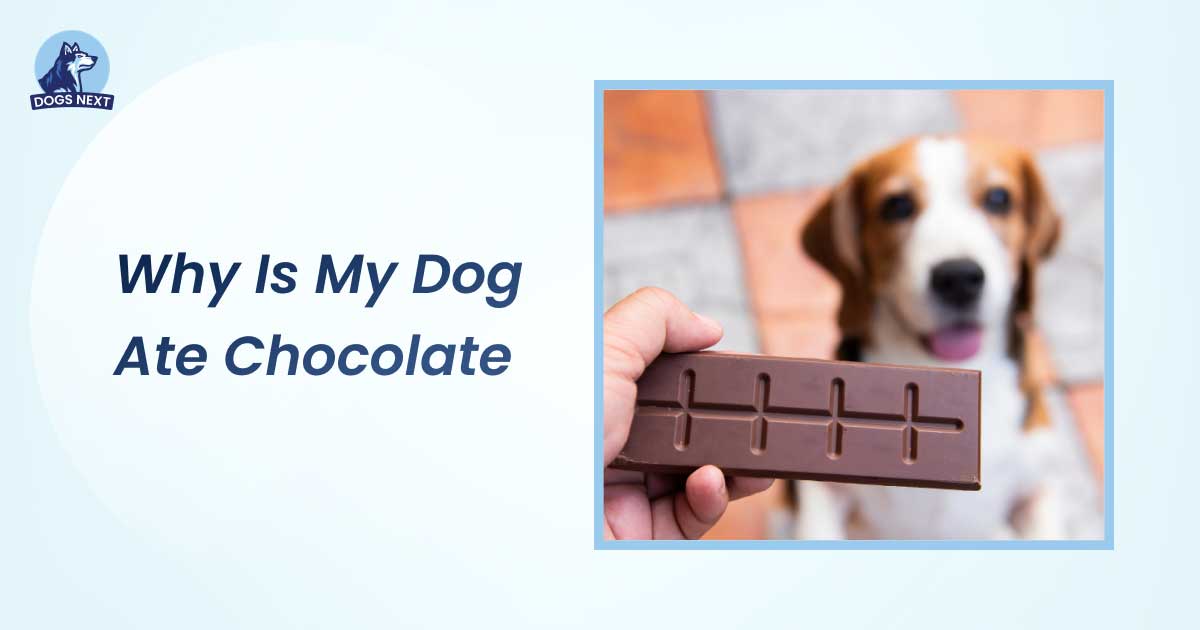Chocolate is toxic to dogs and can cause serious health issues. Seek immediate veterinary attention if your dog ate chocolate.
Dogs are naturally curious and often explore their environment by tasting different things. Chocolate contains theobromine and caffeine, compounds that are harmful to dogs. Even small amounts can lead to symptoms like vomiting, diarrhea, rapid breathing, and seizures. Dark chocolate and baking chocolate are particularly dangerous due to higher theobromine content.
Always keep chocolate out of your dog’s reach to prevent accidental ingestion. Prompt veterinary care can make a significant difference in outcomes, so act quickly if your dog consumes chocolate. Being aware of the dangers helps ensure your pet’s safety and well-being.
Overview Of The Issue
Dogs and chocolate are a dangerous mix. Many pet owners don’t realize how harmful chocolate can be for dogs. If your dog eats chocolate, it’s essential to understand why this is a serious issue.
When a dog eats chocolate, it can lead to severe health problems. Chocolate contains theobromine and caffeine, both of which are toxic to dogs. Their bodies can’t metabolize these substances as efficiently as humans can. This toxicity can cause a range of symptoms that can be life-threatening.
What Makes Chocolate Toxic To Dogs?
The main culprits in chocolate are theobromine and caffeine. These substances stimulate the nervous system and the heart. Dogs process these chemicals much slower than humans. This slow processing allows the toxins to build up to dangerous levels in their system.
Types Of Chocolate And Their Toxicity Levels
| Type of Chocolate | Theobromine Content |
| White Chocolate | Low |
| Milk Chocolate | Moderate |
| Dark Chocolate | High |
| Baking Chocolate | Very High |
Symptoms Of Chocolate Poisoning In Dogs
- Vomiting
- Diarrhea
- Increased Heart Rate
- Restlessness
- Seizures
How Much Chocolate Is Dangerous?
The amount of chocolate that can be harmful varies. Factors include the dog’s size, the type of chocolate, and the amount consumed. Even a small amount of dark or baking chocolate can be deadly for a small dog.
What To Do If Your Dog Eats Chocolate
- Contact your vet immediately.
- Provide information about the type of chocolate and the amount consumed.
- Follow your vet’s advice for treatment.
Why Chocolate Is Harmful To Dogs
Chocolate is a delicious treat for humans, but it’s a different story for dogs. Many dog owners worry, “Why did my dog eat chocolate?” and “Why is chocolate harmful to dogs?” Understanding the reasons behind these concerns can help keep our furry friends safe and healthy.
Chocolate contains two substances that are toxic to dogs: theobromine and caffeine. These compounds are stimulants and can cause serious health problems in dogs. Even a small amount of chocolate can lead to severe reactions.
How Theobromine Affects Dogs
Theobromine is the primary toxin in chocolate. Dogs metabolize theobromine much slower than humans. This slow process allows the toxin to build up to dangerous levels. Symptoms of theobromine poisoning include:
- Vomiting
- Diarrhea
- Increased heart rate
- Seizures
- Muscle tremors
Types Of Chocolate And Their Theobromine Content
| Type of Chocolate | Theobromine Content (mg/oz) |
| White Chocolate | 0.1 mg/oz |
| Milk Chocolate | 44-60 mg/oz |
| Dark Chocolate | 135 mg/oz |
| Baking Chocolate | 450 mg/oz |
How Caffeine Affects Dogs
Caffeine is another dangerous component in chocolate. It can lead to hyperactivity, restlessness, and rapid breathing in dogs. Caffeine toxicity can cause the same symptoms as theobromine poisoning. Dogs are more sensitive to caffeine than humans, making it essential to keep chocolate away from them.
Signs Your Dog Ate Chocolate
If you suspect your dog has eaten chocolate, look for these signs:
- Restlessness
- Increased heart rate
- Vomiting
- Diarrhea
- Muscle tremors
Recognizing these symptoms early can make a big difference. Contact your vet immediately if you notice any of these signs.
Preventing Chocolate Ingestion
Prevention is always better than cure. Follow these tips to keep your dog safe:
- Store chocolate out of reach.
- Educate family members and guests about the dangers.
- Use pet-proof containers for chocolate.
Symptoms Of Chocolate Poisoning
Introduction paragraph about Why is My Dog Ate Chocolate and Symptoms of Chocolate Poisoning:
Chocolate is a delightful treat for humans, but it can be dangerous for dogs. Dogs are attracted to the sweet and rich flavor, but their bodies can’t process theobromine, a chemical found in chocolate. Understanding the symptoms of chocolate poisoning can help you act quickly if your dog eats chocolate.
Common Signs To Watch For
Recognizing the common signs of chocolate poisoning is crucial. Early detection can make a big difference. Here are some symptoms:
- Vomiting: This is often the first sign. Your dog may vomit repeatedly.
- Diarrhea: Loose stools can occur within hours of ingestion.
- Increased Thirst: Your dog may drink more water than usual.
- Restlessness: Watch for pacing or an inability to settle down.
- Excessive Urination: Frequent trips outside can be a clue.
- Elevated Heart Rate: Feel your dog’s chest. A rapid heartbeat is a serious sign.
- Muscle Tremors: Shaking or twitching may occur.
- Seizures: In severe cases, seizures can happen.
Here’s a table summarizing these symptoms:
| Symptom | Description |
| Vomiting | Frequent vomiting episodes |
| Diarrhea | Loose stools |
| Increased Thirst | Drinking more water |
| Restlessness | Pacing or inability to settle |
| Excessive Urination | Frequent urination |
| Elevated Heart Rate | Rapid heartbeat |
| Muscle Tremors | Shaking or twitching |
| Seizures | Severe shaking episodes |
Severity Based On Amount And Type Of Chocolate
The severity of chocolate poisoning depends on the type and amount of chocolate consumed. Different chocolates contain varying levels of theobromine:
- White Chocolate: Contains the least theobromine. Symptoms are usually mild.
- Milk Chocolate: Higher theobromine content. Moderate symptoms are likely.
- Dark Chocolate: Very high theobromine levels. Can be very dangerous.
- Baking Chocolate: Extremely high theobromine content. Highly toxic.
Here’s a table to help you understand the severity based on the type of chocolate:
| Type of Chocolate | Theobromine Content | Severity |
| White Chocolate | Low | Mild |
| Milk Chocolate | Moderate | Moderate |
| Dark Chocolate | High | Severe |
| Baking Chocolate | Very High | Highly Toxic |
The amount of chocolate is also a factor. Larger dogs can tolerate more than smaller dogs. Even a small amount of dark or baking chocolate can be fatal for small breeds. Always contact your vet if your dog eats any chocolate.
Immediate Actions To Take
When your dog eats chocolate, it’s crucial to act quickly. Chocolate contains theobromine, which is toxic to dogs. Knowing the immediate actions to take can save your furry friend’s life. Here’s a guide on what steps to follow.
First Aid At Home
If you find your dog has ingested chocolate, you need to act fast. Here are some steps to follow:
- Stay Calm: Panicking will not help your dog. Stay calm and collected.
- Remove Access: Take away any remaining chocolate to prevent further ingestion.
- Check the Amount: Determine how much chocolate your dog ate. The type of chocolate matters too. Dark chocolate is more toxic than milk chocolate.
- Induce Vomiting: If your dog ate chocolate within the last two hours, you could induce vomiting. Use a 3% hydrogen peroxide solution. Administer one teaspoon per 10 pounds of body weight. Do not exceed three teaspoons. Walk your dog around to help the solution work.
- Hydrate: Offer fresh water to keep your dog hydrated.
If your dog shows severe symptoms like seizures or rapid breathing, skip the first aid and seek professional help immediately.
When To Call The Vet
Calling the vet can be a life-saving decision. Here’s when you should pick up the phone:
- Large Quantity: If your dog ate a large amount of chocolate, call the vet immediately.
- Type of Chocolate: Dark or baking chocolate is more dangerous. Contact the vet if your dog ate these types.
- Symptoms Appear: Watch for symptoms like vomiting, diarrhea, restlessness, or seizures. These require urgent vet attention.
- Small Dogs: Small breeds are more at risk. If you have a small dog, it’s better to call the vet even if the amount seems minor.
Provide the vet with information about the type and amount of chocolate ingested. This helps them decide the best course of action.
Emergency Treatment Options
If your dog needs emergency treatment, the vet has several options:
- Activated Charcoal: This can absorb toxins and prevent further absorption in the stomach.
- IV Fluids: Intravenous fluids help flush out toxins and keep your dog hydrated.
- Medications: The vet may administer drugs to control symptoms like seizures or high heart rate.
- Gastric Lavage: In severe cases, the vet may perform gastric lavage to remove toxins directly from the stomach.
Emergency treatment is crucial for severe chocolate poisoning. Early intervention increases the chances of a full recovery.
Prevention Tips
Dogs love to explore and eat things they shouldn’t, and chocolate is one of the most dangerous foods for them. Preventing your dog from eating chocolate is crucial for their health. Here are some tips to help you keep your furry friend safe and sound.
How To Keep Chocolate Out Of Reach
Keeping chocolate away from your dog is essential. Dogs are curious, and they can find hidden treats. Here are some effective ways to ensure chocolate stays out of their reach:
- Store chocolate in high cabinets: Place chocolate on high shelves or in cabinets that your dog cannot access. Use child-proof locks if necessary.
- Use sealed containers: Store chocolate in airtight containers. This not only keeps the chocolate fresh but also hides the scent from your dog.
- Keep it out of sight: Avoid leaving chocolate on countertops or tables. Always put it away after use.
- Secure trash cans: Dogs often rummage through trash. Use bins with secure lids or place the bin in a cabinet.
Consider using a table for quick reference:
| Method | Details |
| High Cabinets | Store chocolate on high shelves |
| Sealed Containers | Use airtight containers to hide scent |
| Out of Sight | Avoid leaving chocolate on tables |
| Secure Trash Cans | Use bins with secure lids |
Educating Family Members And Guests
Everyone in your home should know the dangers of chocolate for dogs. Here are some tips to educate family members and guests:
- Explain the risks: Tell them why chocolate is harmful to dogs. Explain the symptoms of chocolate poisoning, such as vomiting and seizures.
- Set house rules: Make it clear that chocolate should never be left out. Remind them to store it properly after use.
- Supervise children: Kids often share their snacks. Teach them that chocolate is a treat for humans only.
- Inform guests: When guests arrive, inform them about the no-chocolate rule. Ask them to keep their treats out of reach.
Here is a quick guide for educating others:
| Action | Purpose |
| Explain Risks | Inform about chocolate’s dangers |
| Set House Rules | Ensure chocolate is stored properly |
| Supervise Children | Prevent kids from sharing chocolate |
| Inform Guests | Keep guests aware of the rules |
By educating everyone in your home, you can create a safe environment for your dog. Make sure that chocolate is always kept out of their reach and that everyone understands the importance of this rule.
Alternative Foods
Dogs eating chocolate can be dangerous. Chocolate contains theobromine, which is toxic to dogs. If your dog has eaten chocolate, it’s essential to seek veterinary care immediately. While chocolate is harmful, there are many safe and healthy alternative foods for dogs. These options can satisfy their cravings and keep them healthy.
Safe Fruits For Dogs
Many fruits are safe and nutritious for dogs. Apples are a great choice. They are low in fat and high in fiber. Blueberries are another excellent option. They are packed with antioxidants and vitamins. Bananas are also safe and provide potassium and vitamins.
Healthy Vegetables
Carrots are a wonderful snack for dogs. They are low in calories and high in fiber and vitamins. Green beans are another good choice. They are full of essential nutrients and low in calories. Sweet potatoes are also safe and provide a good source of vitamins and fiber.
Safe Dairy Products
Some dogs can enjoy dairy in moderation. Plain yogurt is a good option. It provides probiotics, which are good for digestion. Cottage cheese is also safe and is high in protein. Always choose low-fat options and avoid any added sugars or flavors.
Protein-packed Alternatives
Dogs need protein for energy and muscle health. Cooked chicken is a great option. It is easy to digest and packed with protein. Lean beef is another safe choice. Make sure it is cooked well and free of any seasonings. Fish, such as salmon, is also beneficial. It provides omega-3 fatty acids, which are good for the skin and coat.
Grains And Carbs
Oatmeal is a healthy grain that dogs can eat. It is a good source of fiber and easy to digest. Brown rice is another safe option. It is full of essential nutrients and easy on the stomach. Quinoa is also beneficial. It provides protein and various vitamins and minerals.
Dog-safe Snacks
Peanut butter is a favorite among many dogs. It is high in protein and healthy fats. Make sure it does not contain xylitol, which is toxic to dogs. Pumpkin is another safe snack. It is good for digestion and full of fiber. Coconut is also safe and provides healthy fats and vitamins.
| Food | Benefits |
| Apples | Low in fat, high in fiber |
| Blueberries | Rich in antioxidants |
| Carrots | Low in calories, high in vitamins |
| Yogurt | Good for digestion |
| Chicken | High in protein |
| Oatmeal | Good source of fiber |
Frequently Asked Questions
How Much Chocolate Will Hurt A Dog?
The amount of chocolate harmful to a dog depends on the dog’s size and the chocolate type. Dark chocolate is more toxic. Even small amounts can cause illness. Always consult your vet if your dog ingests chocolate.
Will My Dog Be Ok After Eating Chocolate?
Chocolate is toxic to dogs. Contact your vet immediately if your dog eats chocolate. Symptoms may include vomiting, diarrhea, and seizures. Early treatment is crucial.
What To Give A Dog If They Ate Chocolate?
Contact a vet immediately. Induce vomiting only if instructed. Activated charcoal can help absorb toxins. Monitor for symptoms like vomiting or seizures.
Will One M&M Hurt A Dog?
One M&M likely won’t harm a dog, but chocolate can be toxic. Consult a vet if concerned.
Conclusion
Understanding the dangers of chocolate to dogs is crucial for every pet owner. Immediate action can save your dog’s life. Always keep chocolate out of reach and contact your vet if ingestion occurs. Your pet’s health and safety should always be a top priority.
Stay informed and protect your furry friend.

I’m David, an expert contributor and writer, with two furry friends of my own, I know the challenges of raising and caring for dogs. From training to nutrition and health, my goal is to provide valuable insights and advice to help create strong bonds and happy, healthy lives. Find me in Twitter.




